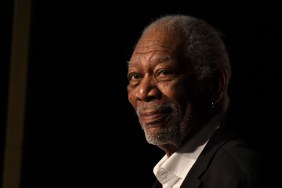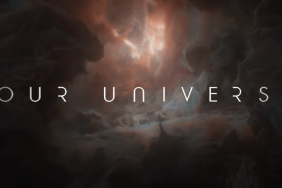
The Story of God with Morgan Freeman is back on National Geographic Channel with three new episodes
When it comes to mankind’s greatest existential questions, it’s safe to say that there are no easy answers. That fact proved little obstacle for the first season of National Geographic Channel‘s The Story of God with Morgan Freeman. Over the course of six episodes, Freeman traveled the globe in search of an understanding of man’s theological motives, focused through specific topics and backed by firsthand conversations with all sorts of unique individuals.
Now, as The Story of God launches its second season, Freeman joins longtime producing partner Lori McCreary and fellow EP James Younger for a quick conversation with ComingSoon.net about how The Story of God came to be and about what will be explored over the course of three season two episodes.
ComingSoon.net: How did you three come together for the show in the first place?
Morgan Freeman: We were in Hagia Sophia, looking up on the walls where there were these frescoes. It had been a church and then a mosque and then a museum. We didn’t expect to see any representations of Jesus in these frescoes and we did. We asked if when it was a mosque if it had not been painted over. The guy says, “Oh, no no no. Jesus is not alien to Islam. Jesus is considered one of the prophets. That was a big surprise to us. That really echoed with Lori because she thought, “I know quite a lot about this.”
Lori McCreary: Yeah, it was shocking to us that Islam included stories of the virgin birth and of Jesus. We thought, “We didn’t know this. Perhaps others may not know it.” We took it upon ourselves to tell the story.
James Younger: We started working together on “Through the Wormhole” a couple of years after that and it then took a couple of years to get this idea together. Finally we teamed up with National Geographic, who are such incredible partners. That’s how the series was born.
CS: Each episode has a unique theme and unique locations and interviews tied to that theme. What is the process of dividing up the themes and finding the right people with whom to converse?
James Younger: We’re searching for commonalities, basically, within religions and then there’s all these ideas that every person alive has asked themselves. What happens when I die? Should I be good or is it okay for me to be evil? What does God look like? We took those ideas and explored those in different faiths around the world. That’s how the series was born. We’re looking at universal questions.
Lori McCreary: We ultimate chose the topics that we ourselves wanted to know more about. The kind of things we talk about over the dinner table. Why am I here? Do I have a purpose?

CS: What sort of topics are we going to be seeing in season two?
James Younger: We have three amazing episodes. One of them is called “The Chosen One” and that looks at people who have a special place in faith. We look at reincarnated Buddhist Lama teachers. In one episode, we met Chief Argol Looking Horse of the Lakota, Dakota, and Nakota Nations.
Morgan Freeman: We found that usually when people become “chosen,” it happens at an early age. Chief Arvol was in his 20s. That’s kind of a wild card. He got really hurt and was in the hospital. His grandmother, who died, appeared to him and told him, “You have other things to do. Straighten up.” Now, he’s the keeper of the sacred bundle for those tribes.
James Younger: Then there’s an episode about Heaven and Hell.
Lori McCreary: That’s my favorite episode. It’s so exciting to see how different people in different religions think about Heaven and Hell. So many religions have versions of both and, surprisingly, they’re not that dissimilar to each other.
James Younger: Then the final episode is called “Proof of God.” We’re not trying to prove God, but we’re asking how different people of different religions try and look for their proof of God. We spoke to a man who has an incredible story of survival on 9-11. He worked in the North Tower and his wife in the South Tower. He heard God’s voice on that day and, in the darkest of hours, God proved himself to him. We traveled the world. In Namibia, there are healers who find God in nature and in the rules and equations of the universe. That brings them closer to God.
Lori McCreary: There’s also a woman who had a near death experience and saw Heaven. She said that God is love. That was particularly poignant to me. I have had an experience like this myself.
James Younger: When Morgan and Lori were working on their first movie together in 1992, she had an experience in Africa where she was exposed to something where her heart stopped and she was exposed to this incredible vision. We’re always looking for stories that everyone can relate to.
CS: One of the most intriguing episodes for me in the first season was the one that looked at evil and where you spoke with a wholly non-repentant killer.
Morgan Freeman: If you’re going to talk about God and Heaven, you’re going to have to talk about good and evil. That’s how they manifest. Good, God and evil, the Devil. We wondered about the existence of evil. Why is it here?
James Younger: You usually think of evil as people who are behaving aggressively and selfishly and who just don’t care about other people. In India, we had an interesting experience where we went to a healing pond. There, the families try to wash themselves of evil. The thought for them is that evil comes from the spirit of their ancestors who are not happy. The way to take evil out of their lives is to offer blessings of clothing and food to their unhappy ancestors. They can go off safely and the shadow of evil will walk away. It’s dealing with the Devil through compassion.
Lori McCreary: It’s hard not to talk about one without the other. That was a hard topic because it meant we had to speak with people that we would rather have avoided. We believe it was ultimately worth it.
You can keep up with The Story of God season two at National Geographic Channel. The first season is now available on DVD.









